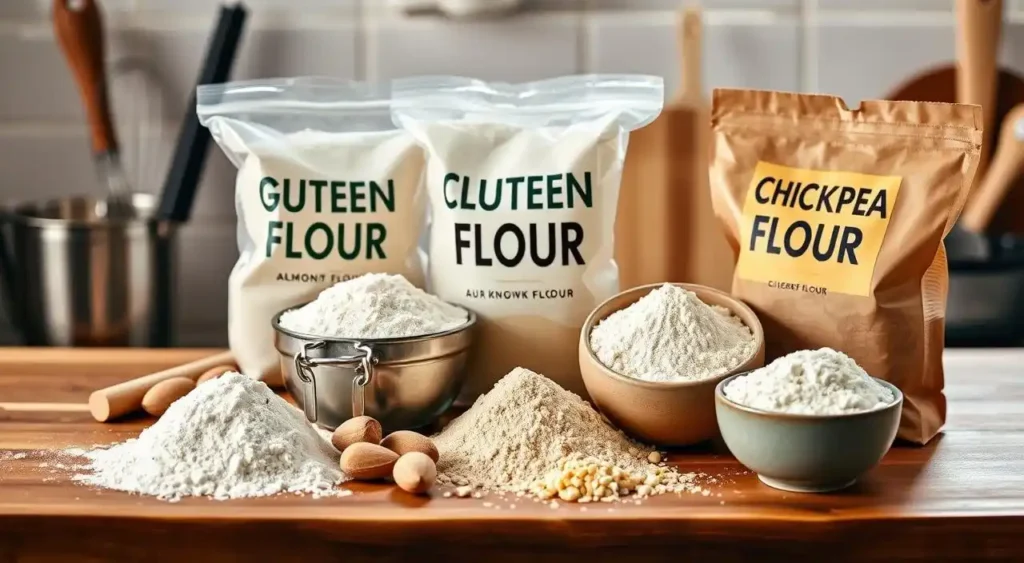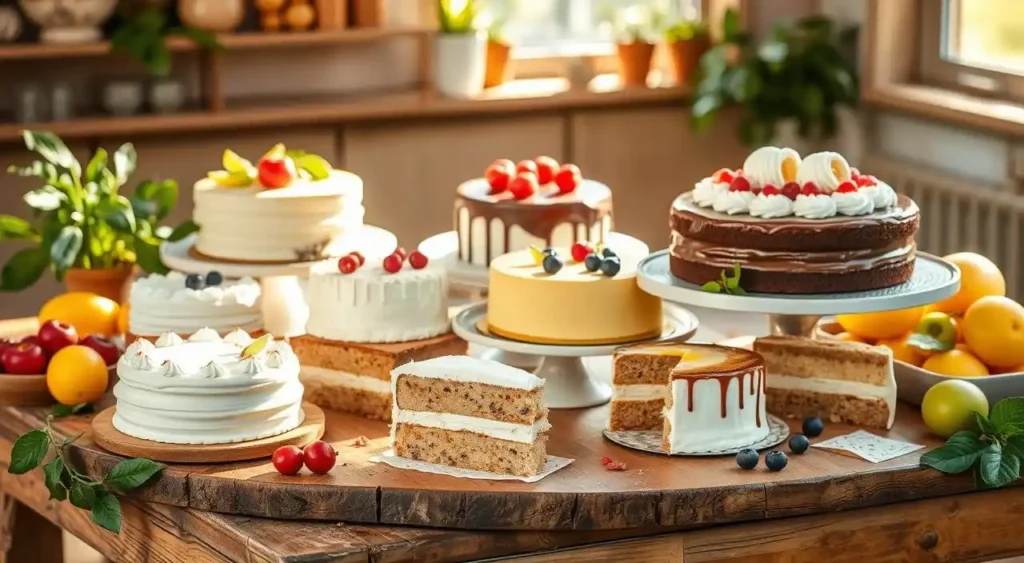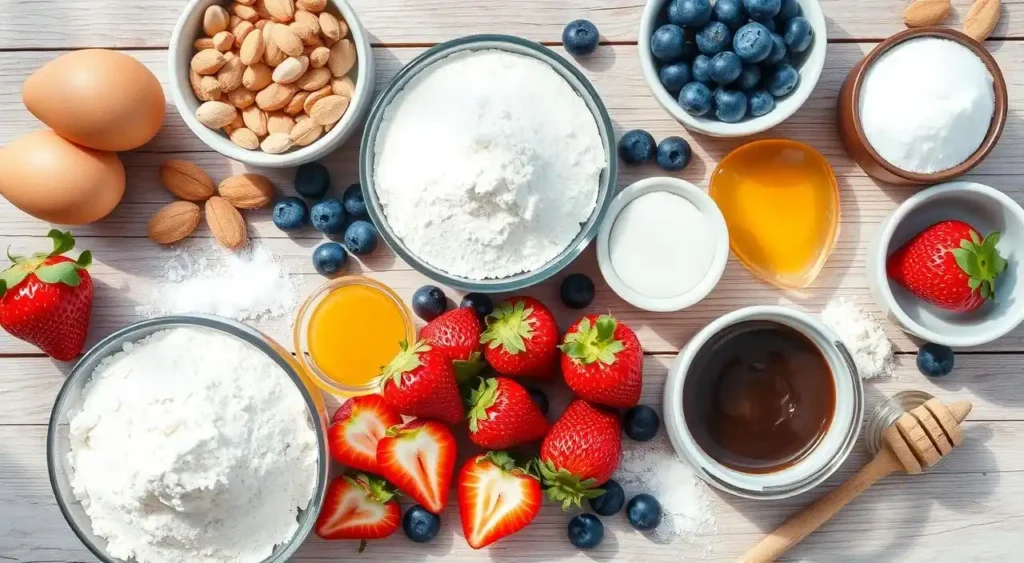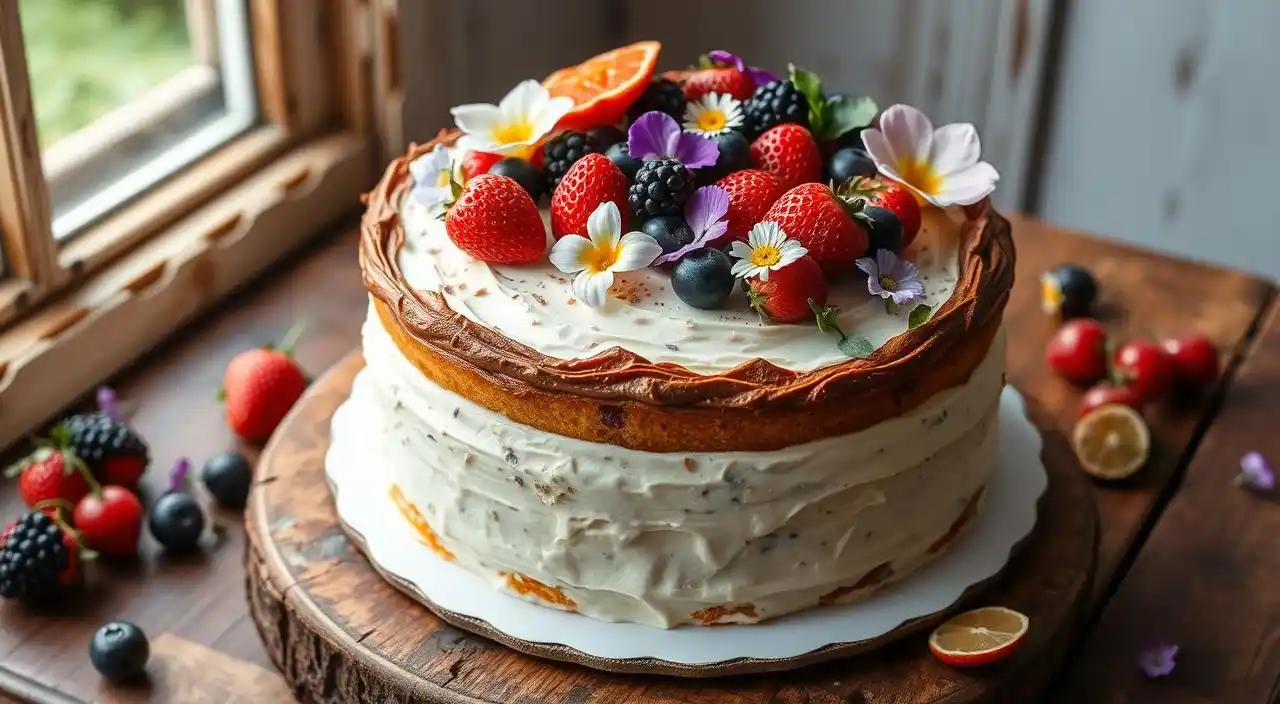Imagine biting into a moist, decadent cake. Your taste buds dance with delight. Then, you find out it’s gluten-free. For years, a gluten-free cake that rivals traditional ones seemed like a dream. But now, you can enjoy delicious gluten-free cakes without giving up flavor or texture.
In this guide, we’ll dive into gluten-free baking. We’ll debunk myths and show you how to make cakes that wow everyone. You’ll learn about gluten-free ingredients and essential techniques. Soon, you’ll be baking gluten-free cakes that everyone will love.
Table of Contents
Understanding Gluten-Free Cake Basics
Baking gluten-free cakes can seem tough at first. But knowing the basics can help you make moist and tasty treats. The secret is choosing the right flours and learning about binding agents.
Common Gluten-Free Flour Alternatives
Gluten-free baking lets you try many flours, not just wheat. You can use almond flour, rice flour, coconut flour, and oat flour. Each flour changes how your cake feels and looks. So, it’s important to try different ones to find what works best.
The Science Behind Gluten-Free Baking
Gluten, found in wheat, rye, and barley, makes baked goods chewy. Without it, gluten-free baking needs a special approach. Knowing how eggs, fats, and leavening agents work helps make the perfect gluten-free cake.
Essential Binding Agents
Gluten-free bakers use special ingredients to keep their cakes together. Xanthan gum, psyllium husk, and ground flax or chia seeds are common. They help the cake stay firm and prevent it from falling apart.

Learning about gluten-free baking opens up a world of possibilities. You can make moist, delicious cakes that are just as good as the traditional ones. Try different flours and binding agents to find your favorite gluten-free recipes.
Benefits of Making Your Own Gluten-Free Cakes
Baking your own homemade gluten-free cakes has many benefits. It’s not just about following a gluten-free diet. You get to enjoy a rewarding experience in your kitchen.
One big plus is being able to tailor your cakes to your liking. Unlike store-bought ones, homemade gluten-free cakes let you pick the ingredients. This way, you can make sure they fit your health and taste needs perfectly.
Another great thing is saving money. By baking at home, you can cut down on costs. This lets you enjoy your favorite desserts without spending too much.
“The satisfaction of creating a delicious, gluten-free cake that your family and friends can enjoy is truly unparalleled.”
The best part of homemade gluten-free baking is the pride you feel. Making a tasty, gluten-free treat for your loved ones is incredibly rewarding. It makes all the effort worth it.

Essential Ingredients for Perfect Gluten-Free Cake
Baking gluten-free cakes is all about mixing the right ingredients. You need flavors that pop and a moist, tender crumb. Start your gluten-free baking journey with the key ingredients that make cakes stand out.
Best Flour Combinations
Wheat flour is out for gluten free bakers. But, there are many other flours that can give your cakes structure and texture. Try mixing gluten-free cake ingredients like almond flour, coconut flour, and tapioca starch. This mix can make your cakes taste like they’re made with wheat flour.
Natural Sweeteners and Alternatives
Forget refined sugars for your gluten free cakes. Instead, use natural sweeteners for cakes like honey, maple syrup, and coconut sugar. They add sweetness and unique flavors. You can use them alone or together for cakes that are both tasty and healthy.
Must-Have Pantry Items
- Gluten-free flours (such as almond, coconut, and tapioca)
- Xanthan gum or guar gum (for binding and structure)
- Natural sweeteners (honey, maple syrup, coconut sugar)
- Eggs or egg replacers (for structure and moisture)
- Dairy-free milk alternatives (almond, coconut, or oat milk)
- Baking soda and baking powder (for leavening)
- Vanilla extract (for flavor)
- Cocoa powder (for chocolate-based cakes)
Having these gluten-free cake ingredients in your pantry will help you make any gluten-free cake recipe with ease and success.

Common Mistakes to Avoid in Gluten-Free Baking
Gluten-free baking is a fun journey, but it’s key to avoid common errors. To make great gluten-free cakes, pay attention to details and be ready to tweak your methods. We’ll look at gluten-free baking mistakes to dodge and share tips for gluten-free cakes for perfect results.
One big mistake is not measuring ingredients right. Gluten free flours are denser than regular flour, so volume measurements can mess up your recipe. Always use a kitchen scale for exact measurements.
Another error is mixing the batter too much. This makes the cake tough and dense. Gluten-free cakes need a light touch. Mix ingredients gently, avoiding overmixing that activates the gluten-free flours.
- Avoid common gluten-free baking mistakes like inaccurate measurements and over-mixing.
- Follow tips for gluten-free cakes by using a kitchen scale, gently folding the batter, and selecting the right flour blends.
Choosing the right flour mix is key for gluten-free cake success. Try different flours like almond, coconut, or rice to find the best mix for your recipe. Feel free to mix and match for the perfect texture and taste.
| Mistake | Tip |
|---|---|
| Inaccurate ingredient measurements | Use a kitchen scale to weigh ingredients |
| Over-mixing the batter | Gently fold the ingredients together |
| Selecting the wrong flour blend | Experiment with a variety of gluten-free flour options |
By fixing these gluten-free baking mistakes and using the right tips for gluten-free cakes, you’ll make moist, tasty, and beautiful gluten-free cakes. They’ll impress your taste buds and fulfill your cravings.
Simple Techniques for Moist Gluten-Free Cake
Making a moist gluten-free cake might seem hard, but it’s easier than you think. With the right methods, you can bake cakes that are just as good as those made with wheat. These tips will help you get better at moist gluten-free cake and gluten-free baking techniques, whether you’re experienced or new.
Proper Mixing Methods
The secret to a great gluten-free cake is in how you mix it. Unlike regular cakes, gluten-free batter needs a gentle touch. Mix the dry ingredients just until they’re combined, avoiding hard stirring that can make the cake tough.
Temperature Control Tips
Keeping the right temperature is key for moist gluten-free cake baking. Make sure your oven is at the right temperature. Don’t open the oven door too often, as it can make the cake fall. Also, try baking at a slightly lower temperature for longer to prevent the outside from getting too brown.
Moisture Retention Strategies
- Add ingredients like applesauce, mashed bananas, or pureed fruit to keep your cake moist.
- Use a mix of gluten-free flours for better moisture retention.
- Don’t overbake your cake. It can dry out quickly. Check it often with a toothpick or cake tester.
By using these gluten-free baking techniques, you can make moist, tasty gluten-free cakes. Try different ingredients and methods to find what works best for you.
Quick and Easy Flourless Chocolate Cake Recipe
Indulge in the rich, decadent flavors of a gluten-free chocolate cake that’s surprisingly simple to make. This flourless chocolate cake recipe is a must-try for any chocolate lover looking for an easy, yet show-stopping dessert.
The secret to this easy flourless chocolate cake is in the quality of the ingredients and the technique. By using high-quality chocolate and a few simple steps, you can create a moist, fudgy cake that will impress your guests without the need for any gluten-containing flour.
Ingredients:
- 8 ounces high-quality dark chocolate, chopped
- 1/2 cup (1 stick) unsalted butter, cut into pieces
- 3 large eggs, at room temperature
- 1/2 cup granulated sugar
- 1/4 cup cocoa powder
- 1/4 teaspoon salt
Instructions:
- Preheat your oven to 375°F (190°C). Grease an 8-inch round baking pan and line the bottom with parchment paper.
- In a large heatproof bowl, combine the chopped chocolate and butter. Set the bowl over a saucepan of simmering water, making sure the bowl doesn’t touch the water. Stir occasionally until the chocolate and butter are completely melted and smooth. Remove from heat and let cool slightly.
- In a separate bowl, whisk the eggs and sugar together until the mixture is light and fluffy, about 2-3 minutes.
- Gently fold the egg mixture into the melted chocolate mixture until well combined. Sift in the cocoa powder and salt, and gently fold until no dry pockets remain.
- Pour the batter into the prepared baking pan and smooth the top.
- Bake for 25-30 minutes, or until the edges are set, and the center is still slightly soft. The cake will continue to set as it cools.
- Allow the cake to cool completely in the pan, then run a knife around the edges and invert it onto a serving plate.
Serve this gluten-free chocolate cake with a dollop of whipped cream, a sprinkle of powdered sugar, or your favorite ice cream. Enjoy the rich, fudgy texture and intense chocolate flavor in every bite!
Converting Traditional Recipes to Gluten-Free
If you love baking, making your favorite cakes gluten-free might seem hard. But, with the right steps and a few tricks, you can make delicious gluten-free treats. You won’t have to give up on taste or texture.
Ingredient Substitution Guide
For gluten-free cake success, finding the right substitutes is key. Start by swapping wheat flour for a mix of gluten-free flours. Try using:
- Brown rice flour
- Almond flour
- Coconut flour
- Tapioca flour
Play with different mixes to get the right feel and rise in your gluten-free cakes.
Texture Adjustment Tips
Gluten-free baking needs some tweaks for the perfect texture. To keep your cakes soft and moist, try:
- Xanthan gum or guar gum as a binding agent
- Yogurt, sour cream, or applesauce to add moisture
- Extra eggs or egg whites to improve structure
By following these easy tips for gluten-free recipe conversion and adapting cake recipes, you can turn your favorite cakes into gluten-free treats. These will impress anyone. Take on the challenge and enjoy making amazing gluten-free baked goods.
Decorating Your Gluten-Free Cake
Get creative and turn your gluten-free cakes into stunning works of art! Decorating a gluten-free cake is fun and rewarding. It lets you show off your style and make your treat look amazing. With gluten-free cake decorating and cake frosting ideas, you can do anything.
Frosting Options for Gluten-Free Cakes
The frosting is your canvas for gluten-free cake decorating. Here are some tasty frosting options:
- Creamy buttercream: A classic that adds a smooth texture.
- Tangy cream cheese frosting: A sweet contrast to the cake.
- Silky Italian meringue: Light and airy for your masterpiece.
- Decadent chocolate ganache: Luxurious and velvety.
Edible Decorations and Presentation Tips
Make your gluten-free cake pop with edible decorations. They look great and add flavor. Try:
- Fresh berries, like raspberries, blueberries, or strawberries
- Toasted nuts or shredded coconut for texture
- Candied citrus zest or edible flowers for elegance
- Drizzles of chocolate or caramel sauce for indulgence
For a beautiful gluten-free cake, balance your decorations. Let the cake’s beauty shine. With creativity and detail, you’ll make a dessert that wows everyone.
Storage Tips for Fresh Gluten-Free Cakes
Keeping your gluten free cakes fresh and tasty is key. Whether it’s a leftover slice or a cake for a big event, right storage makes a big difference. Here’s how to keep your gluten free cakes fresh and yummy.
Proper Wrapping Techniques
Wrapping your gluten-free cakes right is important. It keeps them moist and prevents drying. Here are some tips:
- Wrap the whole cake or slices tightly in plastic wrap, making sure there are no air pockets.
- For extra protection, put the wrapped cake in an airtight container or resealable bag.
- When storing a frosted cake, remember the frosting type. Buttercream and ganache are better than whipped cream or meringue.
Freezing Guidelines
Gluten-free cakes can be frozen for up to 3 months. This makes them great for storing gluten-free cakes and freezing gluten-free desserts for later. Here’s how to freeze them right:
- Let the cake cool completely before wrapping and freezing.
- Wrap the cake tightly in multiple layers of plastic wrap or aluminum foil, getting rid of as much air as you can.
- For extra protection, put the wrapped cake in a resealable freezer bag or airtight container.
- Write the date and what’s inside on the package for easy identification.
- When you’re ready to eat it, thaw the cake overnight in the fridge before unwrapping and enjoying.
By using these easy storage and freezing gluten-free desserts tips, you can enjoy your gluten-free cakes at their best. They can be fresh or frozen.
Troubleshooting Common Gluten-Free Cake Issues
Baking gluten free cakes can be tricky, but don’t give up. With some troubleshooting and tips, you can fix common problems. This way, you’ll get moist and tasty results. Let’s look at how to solve common gluten-free cake issues.
Crumbly Texture
A dry and crumbly glutenfree cake often comes from ingredient imbalances. Try adding more fat, like oil or butter, to your recipe. You might also want to add an extra egg or xanthan gum to bind the cake better.
Dense Consistency
A dense cake can happen if you use too much dense flour or don’t mix the batter well. To make it lighter, mix in some lighter flours like almond or rice. Also, make sure to whip the batter well to add air.
Sunken Center
A cake that sinks in the middle might be underbaked or too wet. Bake it longer and try using less liquid or more flour in your recipe.
| Common Gluten-Free Cake Issues | Potential Causes | Solutions |
|---|---|---|
| Crumbly Texture | Imbalance of ingredients | Increase fat content, add binding agents |
| Dense Consistency | Overuse of dense flours, lack of aeration | Use a combination of lighter flours, whip the batter |
| Sunken Center | Underbaking, excess moisture | Bake longer, reduce liquid ingredients, add more flour |
Fixing gluten-free cake problems takes some trial and error. But with patience and these tips, you’ll soon be baking delicious gluten-free cakes that are just as good as the traditional ones.
Seasonal Variations for Your Gluten-Free Cake
Gluten-free baking lets you explore many flavors and use fresh ingredients. You can make cakes that are perfect for any season. Whether you want something light for summer or a warm treat for winter, there’s a recipe for you.
Summer Fruit Options
When it’s warm outside, use fresh summer fruits in your cakes. Try adding strawberries, raspberries, and blueberries for a sweet and colorful touch. For a tropical flavor, mix in mango, pineapple, or coconut.
These fruits make your cake taste amazing and feel light and refreshing.
Holiday Flavor Combinations
- For fall, try a gluten-free pumpkin spice cake with pumpkin, cinnamon, and nutmeg.
- In winter, make a rich chocolate and peppermint cake for holiday parties.
- In spring, enjoy a lemon and lavender cake that captures the season’s spirit.
By using these seasonal flavors, you can make cakes that are not only delicious but also beautiful. Try new ingredients and turn your gluten-free cakes into stunning desserts.
Health Benefits of Gluten-Free Cake Ingredients
Gluten-free living doesn’t mean missing out on cake. Many gluten-free cake ingredients are good for you. Let’s look at some of these benefits.
Almond flour is a favorite in gluten free baking. It’s full of healthy fats, fiber, and vitamins like vitamin E and magnesium. Eating almond flour can help your heart, aid in weight control, and add antioxidants.
Coconut sugar is a natural sweetener used in gluten-free cakes. It’s better for blood sugar than regular sugar. It also has minerals like iron, zinc, and calcium.
- Fruit purees, like applesauce or mashed bananas, add moisture and sweetness. They also give you vitamins, minerals, and fiber.
- Nut butters, like almond or peanut butter, make cakes creamy. They also add protein.
| Ingredient | Health Benefits |
|---|---|
| Almond Flour | Heart-healthy fats, fiber, vitamins, and minerals |
| Coconut Sugar | Lower glycemic index, trace minerals |
| Fruit Purees | Vitamins, minerals, and fiber |
| Nut Butters | Protein and healthy fats |
Using these healthy gluten-free ingredients lets you enjoy cake while being good to your body. Dive into the world of nutritious gluten-free cakes and discover their health perks.
Vegan and Gluten-Free Cake Options
Looking for tasty vegan and gluten-free cakes? You’ll find many creative options. These recipes use egg substitutes and dairy alternatives. They meet different dietary needs without losing flavor or texture.
Egg Replacements
Eggs are key in regular baking. But for vegan and gluten-free cakes, there are great substitutes. Ground flaxseeds or chia seeds mixed with water act like eggs. You can also use egg replacer powders made for vegan baking.
Dairy Alternatives
Traditional dairy like milk, butter, and cream can be swapped for plant-based options. Almond milk, coconut milk, and oat milk work well in vegan and gluten-free cakes. Use coconut oil or vegan margarine instead of butter. For creaminess, try cashew-based or soy-based creams.

